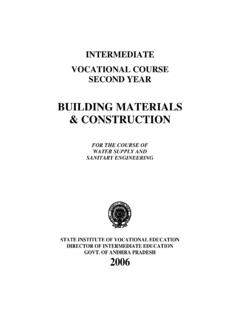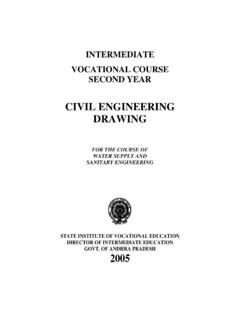Transcription of A Text Book on Automobile Chassis And Body Engineering …
1 A Text Book on Automobile Chassis and body Engineering (A text book for +2 Vocational and Diploma Students of mechanical Engineering ) Author Sri. KUMAR Lecturer in Vocational, Department of Vocational Education, Government Junior College, PALAMANER. Editor Sri. PRAKASA RAO PATNAIK, Lecturer in Engineering ( Automobile ), Department of Vocational Education, Government Junior College AMADALAVALASA contents Chassis , Frame and body Introduction of Chassis frame Layout of the Chassis and its main components Functions of the Chassis frame Types of Chassis frames Various loads acting on the frame State the different bodies used in automobiles Explain the requirements of bodies for various types of vehicles viz. private, commercial etc.
2 Steering Sytem Requirement of the Vehicle steering Types of Steering ears, systems and power steering Steering linkages mechanism under steering, over steering Turning radius Wheel alignment of Ackerman s & Devis Steering gear, Mechanism Steering geometry Caster, Camber, King pin inclination, toe in and toe out Steering defects wheel woubble and shimmy List our the type of steering system used in various vehicles Braking system Explain Functions of brakes Requirements of Automobile brakes Explain stopping time and stopping distance Type of Braking systems Disc and Drum braking system Construction and working of mechanical , hydraulic, and air brakes List out the types of brakes used in various vehicles Suspension System Requirement of a Automobile suspension system Types of suspension system conventional and Independent Types of springs Laminated spring, coil spring, helical spring Need of Shock absorber construction and working of different types of shock absorbers Stabilizer bar and torsion bar List out the type of suspension system used in various vehicles Seat.
3 Door and Window mechanism Construction and working of door lock mechanism Construction and working of manual window regulating mechanism Construction and working of power window regulating mechanism Construction and working of seat adjusting mechanism Air Conditioning of motor vehicles Necessity of Automobile air conditioning Construction and working of passenger car air conditioning Painting of automobiles body painting Different types of painting Spray painting hand painting procedures Automobile Pollution Effects of Automobile pollution on environment and human beings Types of Automobile emissions Treatment of exhaust gases by using catalytic convectors Measurement of percentage of pollutants from petrol & Diesel vehicles with the help of exhaust gas analyzers Legal aspects of motor vehicles Traffic signs and signals Registration requirements Necessity of permits for commercial vehicles Insurance coverage Procedure for obtaining driving licenses Chapter 1 Chassis Frame And body 1 CHAPTER 1 Chassis FRAME AND body Introduction of Chassis Frame: Chassis is a French term and was initially used to denote the frame parts or Basic Structure of the vehicle.
4 It is the back bone of the vehicle. A vehicle with out body is called Chassis . The components of the vehicle like Power plant, Transmission System, Axles, Wheels and Tyres, Suspension, Controlling Systems like Braking, Steering etc., and also electrical system parts are mounted on the Chassis frame. It is the main mounting for all the components including the body . So it is also called as Carrying Unit. Layout of Chassis and its main Components: The following main components of the Chassis are 1. Frame: it is made up of long two members called side members riveted together with the help of number of cross members. 2. Engine or Power plant: It provides the source of power 3. Clutch: It connects and disconnects the power from the engine fly wheel to the transmission system.
5 4. Gear Box 2 Automobile Chassis And body Chapter 1 5. U Joint 6. Propeller Shaft 7. Differential FUNCTIONS OF THE Chassis FRAME: 1. To carry load of the passengers or goods carried in the body . 2. To support the load of the body , engine, gear box etc., 3. To withstand the forces caused due to the sudden braking or acceleration 4. To withstand the stresses caused due to the bad road condition. 5. To withstand centrifugal force while cornering TYPES OF Chassis FRAMES: There are three types of frames 1. Conventional frame 2. Integral frame 3. Semi-integral frame 1. Conventional frame: It has two long side members and 5 to 6 cross members joined together with the help of rivets and bolts. The frame sections are used generally. a. Channel Section - Good resistance to bending b.
6 Tabular Section - Good resistance to Torsion c. Box Section - Good resistance to both bending and Torsion 2. Integral Frame: This frame is used now a days in most of the cars. There is no frame and all the assembly units are attached to the body . All the functions of the frame carried out by the body itself. Due to elimination of long frame it is cheaper and due to less weight most economical also. Only disadvantage is repairing is difficult. 3. Semi - Integral Frame: In some vehicles half frame is fixed in the front end on which engine gear box and front suspension is mounted. It has the advantage when the vehicle is met with accident the front frame can be taken easily to replace the damaged Chassis frame. This type of frame is used in FIAT cars and some of the European and American cars.
7 VARIOUS LOADS ACTING ON THE FRAME: Various loads acting on the frame are 1. Short duration Load - While crossing a broken patch. Chapter 1 Chassis Frame And body 3 2. Momentary duration Load - While taking a curve. 3. Impact Loads - Due to the collision of the vehicle. 4. Inertia Load - While applying brakes. 5. Static Loads - Loads due to Chassis parts. 6. Over Loads - Beyond Design capacity. STATE THE DIFFERENT BODIES USED IN AUTOMOBILES: The Automobile bodies are divided in two groups body Passenger body Commercial body 4 Automobile Chassis And body Chapter 1 According to Chassis design the body can divided into 1.
8 Conventional Type 2. Integral Type 3. Semi- Integral Type According to other usage: 1. Light vehicle Bodies - cars, jeeps 2. Heavy vehicle Bodies Busses, Lorries 3. Medium vehicle Bodies - Vans, Metadoors Chapter 1 Chassis Frame And body 5 REQUIREMENTS OF BODIES FOR VARIOUS TYPES OF VECHILE: The body of the most vehicle should fulfill the following requirements: 1. The body should be light. 2. It should have minimum number of components. 3. It should provide sufficient space for passengers and luggage. 4. It should withstand vibrations while in motion. 5. It should offer minimum resistance to air. 6. It should be cheap and easy in manufacturing. 7. It should be attractive in shape and colour. 8. It should have uniformly distributed load. 9. It should have long fatigue life 10.
9 It should provide good vision and ventilation. 6 Automobile Chassis And body Chapter 1 Short Answer Questions: 1. List out the various components of Chassis ? 2. What are the functions of Chassis frame? 3. List out the types of Chassis frame? 4. What are the frame sections used in Automobiles? 5. What are the requirements of Bodies for various types of vehicles? Essay Type Questions: 1. Draw the layout of conventional Chassis with a neat diagram and explain about various parts on it? 2. What are the different classification of bodies used in Automobiles and explain? Chapter 2 Steering System 7 CHAPTER 2 STEERING SYSTEM Introduction: This system provides the directional change in the movement of an Automobile and maintain in a position as per the driver s decision without much strain on him.
10 REQUIREMENTS OF STEERING SYSTEM: a. It must keep the wheel at all times in to rolling motion with out rubbing on the road. b. This system should associate to control the speed. c. It must light and stable. d. It should also absorb the road shocks. e. It must easily be operated with less maintenance. f. It should have self-centering action to some extent. 8 Automobile Chassis And body Chapter 2 Functions of Steering System: 1. It helps in swinging the wheels to the left or right. 2. It helps in turning the vehicle at the will of the driver. 3. It provides directional stability. 4. It is used to minimize the tyre wear and tear. 5. It helps in achieving self-centering efforts. 6. It absorbs major part of the road shocks. Main Components of Steering System: Chapter 2 Steering System 9 The following are the main components of steering system are 1.



